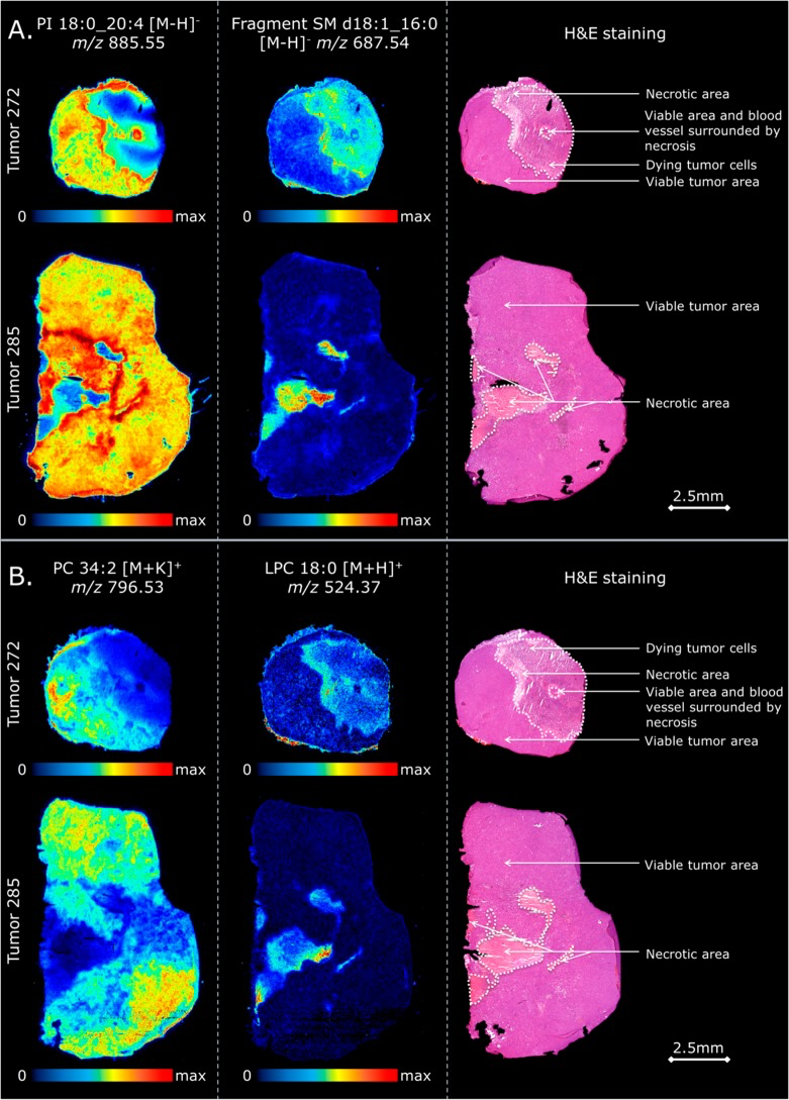
MSI: Molecular imaging for diagnostics, therapeutics and oncology
Interview with Dr. Berta Cillero Pastor, CORE lab manager and Principal Investigator at the division of Imaging Mass Spectrometry at M4i, Maastricht University, part of our Facility of Multimodal Imaging – AMMI Maastricht Node.
Our facility offers a unique infrastructure for state-of-the-art mass spectrometry-based molecular imaging (MSI). Complementary imaging modalities allow determination of the spatial distribution of biomolecules from cellular and tissue surfaces at the nm and µm scale. The range of desorption and ionization methods available, allows the analysis of a variety of biomolecules on complex surfaces ranging from small molecules to proteins.

Please provide a short summary of MSI and list some applications:
Mass spectrometry imaging (MSI) is a label free technique capable of detecting thousands of different molecules in a single experiment while keeping the spatial information of a sample surface. It is most commonly used for biomedical applications but also in the field of material sciences. In general, tissue biopsies are frozen or formalin-fixed paraffin-embedded. After sample collection, sections (typically between 5-20 m) are obtained and placed on glass slides. Matrix-assisted laser desorption/ionization (MALDI)-MSI is one of the MSI modalities and it is widely used due to its broad range of analytical applications. In this case, an organic compound (matrix) is used to coat the samples and assist in the ionization of the analytes. After matrix application, molecules will be then extracted and ionized and collected as a mass spectrum (1 spectrum per pixel). The intensity of the different mass-to-charge (m/z) ratios, can be displayed as a heat map image throughout the sample’s surface.
The MSI technology can be used for instance to study tumour heterogeneity at the molecular level, to study the distribution of metabolites, proteins, lipids or glycans in a particular tissue specimen but also to follow the biodistribution of a drug for PK&PD.
Tell us a bit more about a specific project that was done in your facility using MSI. What scientific questions were you addressing?
One of the applications that is gaining more and more attention is the use of MSI in the field of regenerative medicine. For example, in osteoarthritis (OA) pathology the impairment of cartilage regeneration can be related to a defective chondrogenic differentiation of mesenchymal stromal cells (MSCs). In a collaborative work with the INIBIC institute in Spain, we employed MALDI-MSI at several differentiation stages of human bone MSC spheroids. Our results revealed that UDP-glucuronic acid synthesis and amino sugar metabolism were downregulated in OA human bone MSCs during chondrogenesis compared to healthy cells. This work provided new potential therapeutic targets for OA.

https://pubmed.ncbi.nlm.nih.gov/31980557
Another project in collaboration with the Tromsø University, allowed us to corelate the levels of zinc, citrate, and aspartate with a significant reduction in prostate cancer compared to non-cancer epithelium. The detection of these three molecules simultaneously, might provide a fast method for prostate cancer diagnostics and prognostics.

https://pubmed.ncbi.nlm.nih.gov/31944670
Another application in the field of oncology: Diffuse large B-cell lymphoma (DLBCL) is the most common B-cell non-Hodgkin lymphoma, and up to one-third of tumors ultimately relapse after treatment. In a collaboration with the BRIC institute in Copenhagen, we used a combination of in vivo DLBCL xenograft models and MSI to investigate intratumor heterogeneity. We identified specific lipid markers of viable and necrotic areas. Furthermore, we could monitor metabolic changes and found reduced adenosine triphosphate and increased adenosine monophosphate in tumors that were resistant to the chemotherapy treatment.

https://pubmed.ncbi.nlm.nih.gov/30422637
Why is this MSI best suited to address these questions?
MSI is capable of simultaneously detecting thousands of different molecules in a spatially-resolved manner. In this way, the information obtained is more precise compared to data obtained by conventional mass spectrometry where typically, tissue extracts are used. In this way, the combination of MSI with other imaging modalities such as immunohistochemistry allows the incorporation of pathology information which is key in clinical studies.
What other services do you provide in your facility that would be useful in combination with this type of microscopy?
Laser capture microdissection, proteomics, lipidomics, histology and data co-registration capabilities.
Why should scientists choose your facility for using this technology?
The M4i is a world leader in high resolution molecular imaging of biological surfaces, with concerted research efforts on three topics:
- fundamental physics of desorption and ionization of large biomolecules
- development of innovative instruments and methods for the generation of ultrahigh resolution molecular images
- development and application of mass spectrometry based molecular imaging to molecular histology for nanomedicine and biomedical research
For this unique combination we host many guest researchers every year from different disciplines as part of the CORE lab. Our aim is to offer an open and collaborative environment where research and education meet.
How to apply:
All scientists, regardless of their affiliation, area of expertise or field of activity can benefit from Euro-BioImaging’s pan-European open access services. Potential users of these new technologies are encouraged to submit project proposals via our website. To do so, you can LogIn to access our application platform, choose the technology you want to use and the facility you wish to visit, then submit your proposal. All applications will be processed by the Euro-BioImaging Hub. As usual, users will benefit from advice and guidance by technical experts working at the Nodes, training opportunities, and data management services.
For more information: info@eurobioimaging.eu
More news from Euro-BioImaging


